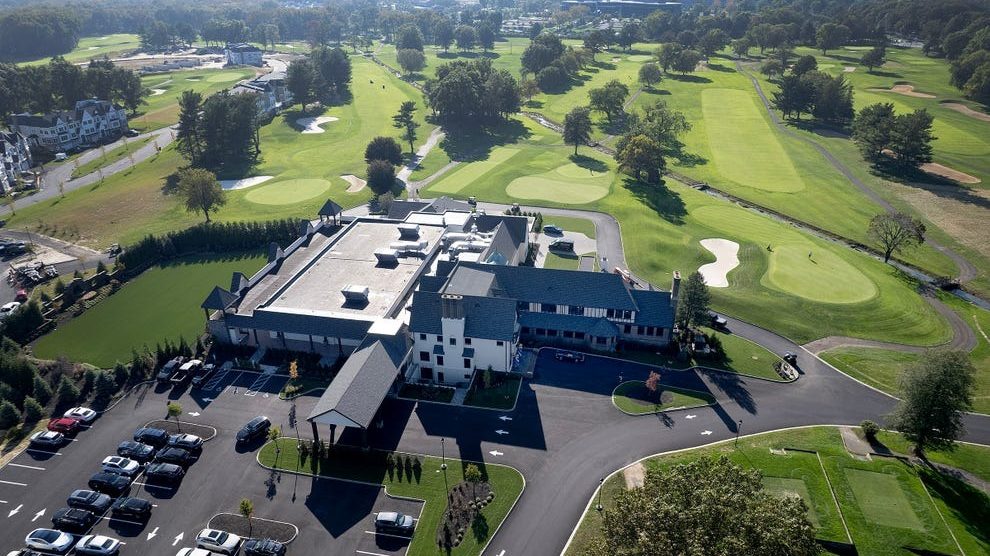EATONTOWN, N.J. – The grill room was buzzing with a young clientele on the lower level of the grand Tudor Revival-style structure formerly known as Gibbs Hall, having recently reopened after a major renovation as the centerpiece of Suneagles Golf Club.
Seated at one end of the space, Ed Turner and Mike McMahon, a pair of Oceanport residents, took a moment to survey the scene.
When Turner, 88, first played the course in 1957, it was the Officer’s Club, with no enlisted men allowed on what was Fort Monmouth Golf Course. McMahon, 80, first walked the links in 1980, and has been a fixture through the place’s metamorphosis, becoming a private golf club this year.
Now the former helicopter pilots, who each served two tours of duty in Vietnam, are the last two retired military still playing at the historic 1926 course, continuing to carry their bags around the layout designed by famed architect A.W. Tillinghast, whose handiwork includes Baltusrol and Bethpage Black.
“We’re the only retired military still here, so he and I are drawn together,” said Turner.
“When I was first here no civilians and no enlisted men here. That’s the way the military was back then. It wasn’t that long after World War II, so we were segregated between officer and enlisted, big time. And when the enlisted started coming here, probably in the early 1970s, it was just senior non-commissioned officers. Then it evolved.”
Fort Monmouth closed in 2011, with Salvatore Martelli, whose Martelli Development Inc. built Colts Neck Golf and Country Club, purchasing the property in 2018. The restoration and expansion of the clubhouse, renamed Tillinghouse, is part of the redevelopment plan that includes 60 luxury market-rate townhouses and 15 affordable townhouses on the course.
Golf, war intertwine
As a member of the 1st Cavalry Division, Turner saw his share of combat action, mostly near the Cambodian border, during his time in Vietnam between 1966 and 1969, getting shot down once.
And while golf was an afterthought most of the time, Turner does recall a course in Saigon where the sand traps weren’t the only hazards.
“On my second tour I would play there sometimes, but it wasn’t something I could do that often,” he said. “The course was actually in an area that had a lot of trouble with the enemy.”
While McMahon never played in Vietnam, where he was part of an aviation detachment of the 196th Infantry Brigade, he was exposed to the game as a youngster growing up in Denver, with his parents dropping him off at the golf course for the day during the summer.
The updated clubhouse, now known as Tillinghouse, at the Suneagles Golf Course in Eatontown is shown Tuesday, October 3, 2023.
And when he returned from Vietnam, he discovered his brother had lost his 8-iron. Fortunately, one of his fraternity brothers at Regis College had made him an offer he was able to collect on.
“He said ‘Mike, if you come back with both arms and legs I’ll buy you a set of clubs,’ ” McMahon said. “I picked them up at the Hogan Factory in Fort Worth, Texas.”
In fact, golf has been a common thread weaving through their 20-plus-year military careers and civilian life.
After leaving the military, Turner began a decades-long career in international business that took him to the Middle East and Asia, including a 12-year stint in Japan. He now spends half the year living in Thailand, where he still plays golf most days.
“Thailand is a golf Mecca,” Turner said. “The way it works for most of us over there – It’s mostly Australians and Europeans – is we don’t join a club like here. I’ll play out of a bar and the bar organizes golf each day and we go to different courses. There are 17 courses in the area and we go every day different places. I don’t walk there but caddies are mandatory. So the caddie drives the cart and I half walk, half ride.”
McMahon, the starter at Jumping Brook Country Club in Neptune, recalls fondly the golfing community that existed at Fort Monmouth back in the day.
“After I retired we used to play with other military.” McMahon said. “There were six colonels who had priority for tee times and they would get the tee times and we would mix in with each one of them every week, so you would play with a different group of guys and it was a lot of fun. “
Links to the past
The Suneagles course has been part of golfing history over the years. World Golf Hall of Famer Byron Nelson won the New Jersey Open there in 1935 for his first professional victory at what was then called Monmouth County Country Club. Fellow Hall of Famer Sam Snead still holds the course record with a 7-under-par 65.
Orville “Sarge” Moody won the All-Army championship there in 1967, before turning pro and winning the 1969 U.S. Open.
Fort Monmouth eventually opened the golf course to civilian contractors at the base, with the course operating as a semi-private course in recent years, before going fully private this year.
“I think the military was forced to open it up from a financial standpoint to keep everything running,” McMahon said. “The military didn’t have enough force structure here to support the course. That’s when they opened it up to the civilian workers.
“Looking into the future, who knows? Netflix (set to build a studio on a 289-acre site) will change the demographics even more.”
But as the redevelopment of Fort Monmouth progresses, changing the landscape at Suneagles dramatically, Turner and McMahon provide an important link to the course’s rich history.
Stephen Edelson is a USA TODAY NETWORK New Jersey sports columnist who has been covering athletics in the state and at the Jersey Shore for over 35 years. Contact him at: @SteveEdelsonAPP; sedelson@gannettnj.com.
The article "These are the last two retired military members at a Tillinghast design that's become a private New Jersey club" was originally published on https://golfweek.usatoday.com/2024/06/26/suneagles-golf-club-new-jersey-a-w-tillinghast/




